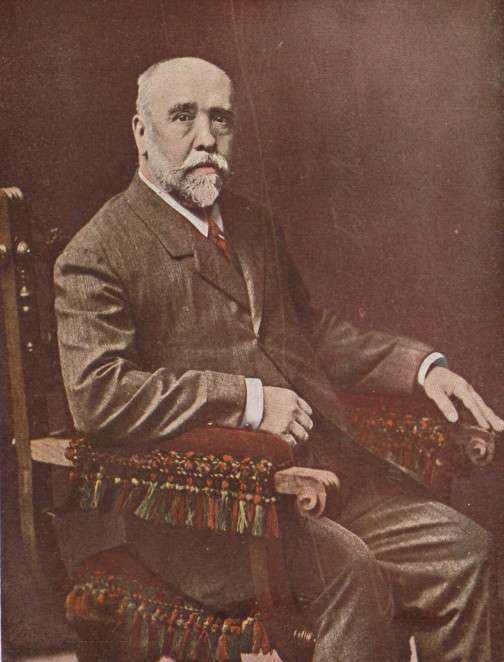
Miguel Echegaray
Classical and Soundtrack
A.k.a. Miguel Echegaray Eizaguirre
Born in Quintanar near Toledo, 29th September 1848, Miguel Echegaray Eizaguirre came from a well-to-do Aragonese family, although his mother was Basque. Miguel's distinguished brother, the poet and statesman José Echegaray, was to become Minister of Public Works and Housing, and eventual Nobel laureate for Literature (1904) - though only after the claims of the great novelist Benito Peréz Galdós were controversially undermined by the Spanish government. Ironically, José's posthumous literary reputation has tended to be overshadowed by that of his brother. Although he wrote his first play Cara y cruz at the age of sixteen, Miguel studied law and philosophy, from 1869 combining legal practise with secretarial duties for his brother. He was an active Radical, holding judicial office 1872-73, but eventually abandoned politics and law to devote himself to his chief love - the theatre. He rose rapidly in this second career, and was eventually recognised by his 1913 election to the Royal Spanish Academy, twelve years before his death in Madrid during 1927. Echegaray's output of 110 stage works, including 21 zarzuelas, would seem prodigious for a playwright today. His zarzuela texts are all within the género chico style. They are outstanding for clever versification, imaginative and offbeat choice of subject, as well as their obvious popular appeal. He wrote El Domingo de Ramos for Bretón (1895); for Chapí, El sombrero de plumas (1902); and four texts for Vives - La rabalera (1907), Juegos malabares (1910), Agua de noria (1911) and El pretendiente (1913). His last zarzuela text was El buen ladrón, for Ortells in 1918. His most substantial legacy arose from a mutually congenial collaboration with Caballero, late in that composer's career. La revista (1892) was followed by a trio of masterworks, El dúo de La africana (1893), La viejecita (1897), and finally Gigantes y cabezudos (1898). The last three sainetes they wrote together - Los estudiantes (1900), La diligencia (1901) and María Luisa (1906) - did not enjoy the same level of success, mainly perhaps because of Caballero's increasing ill health. Gigantes y Cabezudos is perhaps most worthy to stand as Echegaray's memorial. In addition to Echegaray's accustomed literary virtues, its exuberant carnival atmosphere, tight construction, and poignant topicality - the return of the defeated soldiery from the disastrous Cuban war - make it one of the most distinctive and powerful achievements of género chico zarzuela.
Genres
Popular Tracks 

Track list and 30sec audio provided by ![]()
Discography
| Title | Artist | Year | Type |
|---|---|---|---|
| Gigantes Y Cabezudos | Miguel Echegaray, Manuel Fernández Caballero - Ana María Iriarte, Ataúlfo Argenta | 2010 | Album |
| Gigantes Y Cabezudos - La Viejecita | Manuel Fernández Caballero & Miguel Echegaray · Mercedes Melo, Tino Folgar, Pedro Vidal, Matilde Pin, Concha Adúa, Concordio Gelabert | 1998 | Album |
| El Dúo De La Africana | Miguel Echegaray, Manuel Fernández Caballero, Ana María Iriarte, Carlos Munguía, Joaquín Roa, Rafael Maldonado, Coros Cantores De Madrid, Orquesta de Cámara de Madrid, Ataúlfo Argenta | 1966 | Album |
| Gigantes y Cabezudos (Selección) | Manuel Fernández Caballero, Miguel Echegaray, Coro Lirico De Madrid | 1965 | Album |
| Gigantes Y Cabezudos | Miguel Echegaray · Manuel Fernández Caballero / Ana María Iriarte - María Teresa Erdozain - Carlos Munguía - Nicolás Aldanondo / Coro de Cámara del Orfeón Donostiarra Y Gran Orquesta Sinfónica Director: Ataúlfo Argenta | 1962 | Album |
| La Viejecita | Miguel Echegaray, Manuel Fernández Caballero / Ana María Iriarte, Toñy Rosado, Carlos Munguía, Luis S. Luque, Gregorio Gil, Arturo Díaz Martos, Coros Cantores De Madrid, Orquesta de Cámara de Madrid | 1954 | Album |
| Gigantes Y Cabezudos | Manuel Fernández Caballero, Miguel Echegaray | Album | |
| La Viejecita | Manuel Fernández Caballero, Miguel Echegaray | Album |
